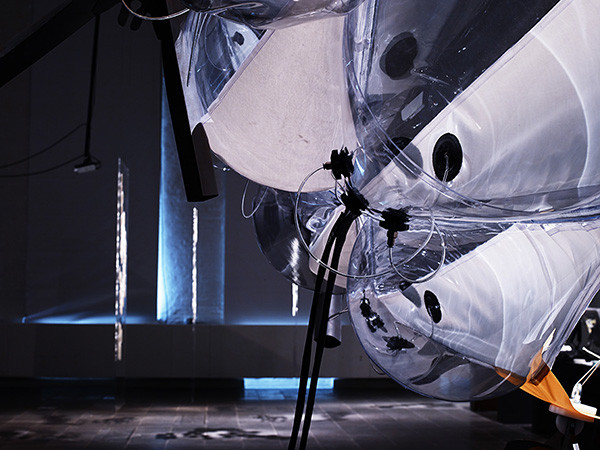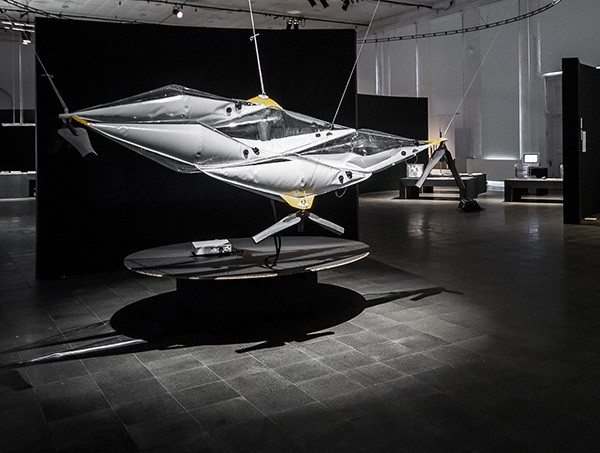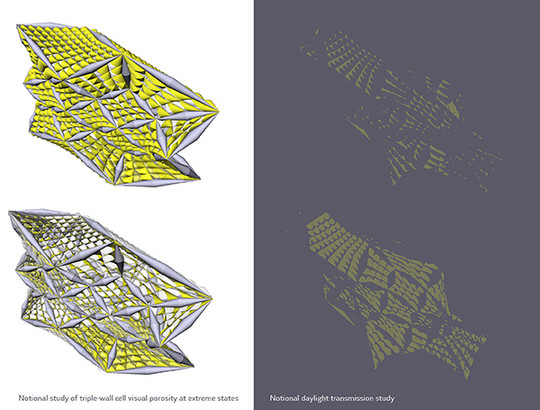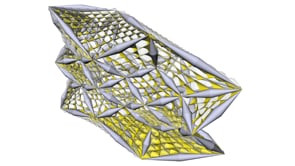
Persistent Model #3

A research collaboration between CITA and Kasper Støy of ITU, Copenhagen
This project builds directly upon prior work (Persistent Model #2) which investigated the computational simulation and physical construction of an irregular tensegrity using self-forming inflated metal components as compression members. Persistent Model #3 examines what the skin for such a tensegrity could be, and what performative roles it might accomplish. The results of the research are demonstrated through the production of a full-scale functioning fragment.

The ambition of the investigation has been to develop a skin that integrates two primary roles – one structural, the other environmental. The structural aim is for the skin to contribute directly to the performance of the tensegrity system, rather than being applied to an independent structure – it therefore needs to provide a continuous tensile boundary against which the compression members can act. The environmental aim for the skin is to provide active shading and control of view – it therefore needs to be locally actuated and have discreet control. .
Pneumatics is investigated as a mechanism for integrating both of the performance concerns of the skin. Using pneumatics extends the language of inflatables from the hard metallic members, complimenting this with lighter soft laminates and foils. The skin is developed as a field of discreetly inflated cells. The cells are divided with a central wall to define two volumes. By selectively inflating one volume or the other, a pressure differential is produced which drives the central wall into the volume with lower pressure.

The central wall is materially divided to form a transparent and opaque section. Depending on solar/observer orientation, this material differentiation alters the qualities of the cell when activated through pressure. Despite the changes of pressure differential between the two volumes of a cell, the external boundary of the cell maintains a constant pressure, allowing it to operate as a tensile surface and contribute to the skin’s structural performance.

The use of computation in the project focuses on managing and informing the ‘states’ of the cells relative to desired internal conditions and external circumstance. Each cell is conceptualized as having two states – cell wall ‘out’ or ‘in’. Even with such a limited description of states at the scale of the cell, across a field of cells a huge time-based design space is established. The challenge therefore becomes one of identifying relevant state patterns to achieve desired spatial/environmental goals.
An evolutionary technique is used to match output states to desired target states. Using this approach means that the system does not need to know desired states in advance, allowing it to respond to ever-changing and unpredictable requirements within a complex ecology of dependencies.
Sponsors
Dreyers Fond
Royal Danish Academy of Fine Arts, School of Architecture, Copenhagen
Exhibitions
Exhibited as part of the show 'What Does It Mean To Make An Experiment', KADK (03-05.2014)
Currently exhbited as part of the 'Smart Flexibility: Advanced Materials and Technologies' touring exhibition.
Venues include: Materfad, Barcelona (06.2014-02.2015) & RMIT, Melbourne (from 06.2015)
Publications
Ayres, P., Støy, K., Stasiuk, D. & Gibbons, H.
“Multi-scalar Shape Change in Pneumatically Steered Tensegrities: a cross-disciplinary interest in using material-scale mechanisms for driving spatial transformations”
FABRICATE: Negotiating Design and Making, Gramazio, F., Kohler, M. & Langenberg, S. (eds), gtaVerlag, pp:256-265
FABRICATE, 2014
Photography
Anders Ingvartsen & Magnus S. Mikkelsen














